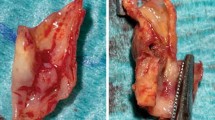Abstract
The purpose of this study was to compare the image quality of the intravascular contrast agent gadofosveset with the extracellular contrast agent gadoterate meglumine in time-resolved three-dimensional magnetic resonance (MR) angiography of the human arteries of the hand. The value of cuff compression technique for suppression of venous enhancement for both contrast agents was also investigated. Three-dimensional MR angiograms of both hands of 11 healthy volunteers were acquired for each contrast agent at 1.5-T, while subsystolic cuff compression was applied at one side. Quantitative and qualitative evaluation were performed and analyzed with Student’s t-test. Visualization of vessels was superior in the images acquired with gadofosveset, especially in the late phases. Quantitative and qualitative evaluation showed significantly higher values for gadofosveset. The cuff compression at the lower arm proved to be an effective method to enhance arterial vessels. In conclusion the blood pool agent gadofosveset is superior for the dynamic imaging of the vessels of the hand when compared with the extracellular contrast agent gadoterate meglumine. To fully utilize the advantages of intravascular contrast agents, venous overlay has to be delayed or reduced, which can be achieved effectively by subsystolic lower arm cuff compression.






Similar content being viewed by others
References
Connell DA, Koulouris G, Thorn DA, Potter HG (2002) Contrast-enhanced MR angiography of the hand. Radiographics 22:583–599
Krause U, Pabst T, Kenn W, Hahn D (2002) High resolution contrast enhanced MR-angiography of the hand arteries: preliminary experiences. VASA Zeitschrift fur Gefasskrankheiten 31:179–184
Bilecen D, Aschwanden M, Heidecker HG, Bongartz G (2004) Optimized assessment of hand vascularization on contrast-enhanced MR angiography with a subsystolic continuous compression technique. AJR Am J Roentgenol 182:180–182
Gluecker TM, Bongartz G, Ledermann HP, Bilecen D (2006) MR angiography of the hand with subsystolic cuff-compression optimization of injection parameters. AJR Am J Roentgenol 187:905–910
Rohrer M, Bauer H, Mintorovitch J, Requardt M, Weinmann HJ (2005) Comparison of magnetic properties of MRI contrast media solutions at different magnetic field strengths. Invest Radiol 40:715–724
Drape JL, Feydy A, Guerini H, Desmarais E, Godefroy D, Le Viet D, Chevrot A (2005) Vascular lesions of the hand. Eur J Radiol 56:331–343
Wang Y, Yu Y, Li D, Bae KT, Brown JJ, Lin W, Haacke EM (2000) Artery and vein separation using susceptibility-dependent phase in contrast-enhanced MRA. J Magn Reson Imaging 12:661–670
Bilecen D, Schulte AC, Bongartz G, Heidecker HG, Aschwanden M, Jager KA (2004) Infragenual cuff-compression reduces venous contamination in contrast-enhanced MR angiography of the calf. J Magn Reson Imaging 20:347–351
Zhang HL, Ho BY, Chao M, Kent KC, Bush HL, Faries PL, Benvenisty AI, Prince MR (2004) Decreased venous contamination on 3D gadolinium-enhanced bolus chase peripheral mr angiography using thigh compression. AJR Am J Roentgenol 183:1041–1047
Wentz KU, Frohlich JM, von Weymarn C, Patak MA, Jenelten R, Zollikofer CL (2003) High-resolution magnetic resonance angiography of hands with timed arterial compression (tac-MRA). Lancet 361:49–50
Prince MR, Chabra SG, Watts R, Chen CZ, Winchester PA, Khilnani NM, Trost D, Bush HA, Kent KC, Wang Y (2002) Contrast material travel times in patients undergoing peripheral MR angiography. Radiology 224:55–61
Wang Y, Chen CZ, Chabra SG, Winchester PA, Khilnani NM, Watts R, Bush HL Jr, Craig Kent K, Prince MR (2002) Bolus arterial-venous transit in the lower extremity and venous contamination in bolus chase three-dimensional magnetic resonance angiography. Invest Radiol 37:458–463
Author information
Authors and Affiliations
Corresponding author
Rights and permissions
About this article
Cite this article
Reisinger, C., Gluecker, T., Jacob, A.L. et al. Dynamic magnetic resonance angiography of the arteries of the hand. A comparison between an extracellular and an intravascular contrast agent. Eur Radiol 19, 495–502 (2009). https://doi.org/10.1007/s00330-008-1149-9
Received:
Revised:
Accepted:
Published:
Issue Date:
DOI: https://doi.org/10.1007/s00330-008-1149-9




